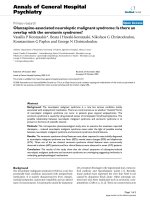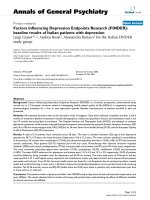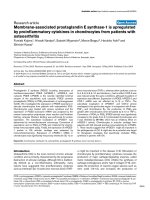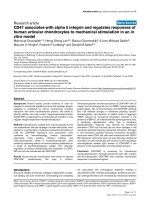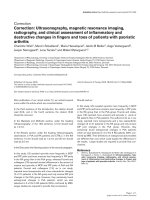Báo cáo y học: "Factors associated with mosquito pool positivity and the characterization of the West Nile viruses found within Louisiana during 2007" ppsx
Bạn đang xem bản rút gọn của tài liệu. Xem và tải ngay bản đầy đủ của tài liệu tại đây (742.56 KB, 8 trang )
Christofferson et al. Virology Journal 2010, 7:139
/>Open Access
RESEARCH
© 2010 Christofferson et al; licensee BioMed Central Ltd. This is an Open Access article distributed under the terms of the Creative Com-
mons Attribution License ( which permits unrestricted use, distribution, and reproduc-
tion in any medium, provided the original work is properly cited.
Research
Factors associated with mosquito pool positivity
and the characterization of the West Nile viruses
found within Louisiana during 2007
Rebecca C Christofferson
1
, Alma F Roy
1,2
and Christopher N Mores*
1
Abstract
Background: West Nile virus (WNV) is an arbovirus of public health importance in the genus Flavivirus, a group of
positive sense RNA viruses. The NS3 gene has a high level of substitutions and is phylogenetically informative. Likewise,
substitutions in the envelope region have been postulated to enable viruses to subvert immune responses. Analysis of
these genes among isolates from positive mosquitoes collected in Louisiana illustrates the variation present in the
regions and provides improved insight to a phylogenetic model. Employing a GIS eco-regionalization method, we
hypothesized that WNV pool positivity was correlated with regional environmental characteristics. Further, we
postulated that the phylogenetic delineations would be associated with variations in regional environmental
conditions.
Results: Type of regional land cover was a significant effect (p < 0.0001) in the positive pool prediction, indicating that
there is an ecological component driving WNV activity. Additionally, month of collection was significant (p < 0.0001);
and thus there is a temporal component that contributes to the probability of getting a positive mosquito pool. All
virus isolates are of the WNV 2002 lineage. There appears to be some diversity within both forested and wetland areas;
and the possibility of a distinct clade in the wetland samples.
Conclusions: The phylogenetic analysis shows that there has been no reversion in Louisiana from the 2002 lineage
which replaced the originally introduced strain. Our pool positivity model serves as a basis for future testing, and could
direct mosquito control and surveillance efforts. Understanding how land cover and regional ecology effects mosquito
pool positivity will greatly help focus mosquito abatement efforts. This would especially help in areas where abatement
programs are limited due to either funding or man power. Moreover, understanding how regional environments drive
phylogenetic variation will lead to a greater understanding of the interactions between ecology and disease
prevalence.
Background
West Nile Virus (WNV) is the most widely distributed
arbovirus in the world, occurring on all continents save
Antarctica [1]. Its lack of vector specificity compared to
other arboviruses has allowed it to use a wide variety of
mosquito species in its enzootic cycles [2]. WNV was
introduced into the United States in 1999 and from its
entry point of New York City it spread across the conti-
nental United States. Phylogenetic evidence traced this
strain to a similar strain isolated in Israel in 1998 [2]. In
2001 a new WNV strain appeared. In 2002, this genotype
became the dominant WN02 strain that was significantly
associated with an increase in numbers of human mor-
bidity and mortality cases in the US. In fact, the number
of deaths from 1999-2001 were significantly less than the
number of deaths in 2002 alone, though whether this
association is due to direct virulence in humans or an
indirect result of the virulence in birds remains unclear
[1,3,4].
WNV is a member of the genus Flavivirus, a group of
positive sense RNA viruses. The genome is composed of
a single open reading frame that produces ten viral pro-
teins: three structural proteins (capsid C, membrane
prM/M, envelope E) and seven non-structural proteins
* Correspondence:
1
Department of Pathobiological Sciences, School of Veterinary Medicine,
Louisiana State University, Baton Rouge, Louisiana, USA
Full list of author information is available at the end of the article
Christofferson et al. Virology Journal 2010, 7:139
/>Page 2 of 8
(NS1, NS2A, NS2B, NS3 NS4A, NS4B, and NS5) [5]. The
NS3 gene plays an important role in the replication of the
virus, encoding a protein with four functions: a serine
protease, a nucleoside triphosphatase, an RNA 5'triphos-
phatase, and a helicase [5]. Phylogenetic analyses of
WNV have most commonly utilized differences in the
envelope protein, but the capsid, prM protein, and non-
structural proteins have also been informative [4,6-12].
Analyses done on complete genomes have given similar
results to trees made from prM and envelope proteins [4].
To determine the genetic variability in Louisiana, the
envelope coding and NS3 coding regions were analyzed.
The NS3 gene has a high level of substitution and is phy-
logenetically informative [11] and mutations in the enve-
lope region have been postulated to enable viruses to
subvert immune responses [13]. Analysis of these genes
would illustrate the variation present in Louisiana as well
as provide improved insight for our phylogenetic model.
Many phylogenetic studies have been geographically
focused [6,8,14,15]. Geographic Information Systems
(GIS) based "region" classifications were successfully used
to model WNV transmission risk in humans in northeast
Ohio where local environmental features to model trans-
mission [16]. Employing a similar eco-regionalization
method, we hypothesized that WNV pool positivity was
correlated with regional environmental characteristics.
Further, we postulated that the phylogenetic delineations
would be associated with variations in regional environ-
mental conditions.
Results
Positive Pool Predictors
The data used in the modelling study were from several
parishes in Louisiana during 2007. There were 611 posi-
tives reported by the Louisiana Animal Disease Diagnos-
tic Laboratory, 165 in our target parishes. Classification
regions were constructed based on land cover data from
the Louisiana GIS Digital Map, May 2007(Figure 1). The
land cover of a parish was determined by the majority
rule. Ouachita and Caddo parishes are, for example, 50-
75% forest lands; East Baton Rouge is a majority devel-
oped area comprised mostly of the urbanized capital of
Baton Rouge [17]. Iberville Parish is classified as wet-
lands, defined as low lying areas saturated with moisture.
Before building the WNV model, we tested several fac-
tors via multinomial regression to determine whether
these were significant predictors of the mosquito species
found, regardless of WNV positivity. Interestingly, no fac-
tors (land cover, month) were significant for the 2007
data. Therefore, it was determined that no noteworthy
correlation existed between these variables and thus no
colinearity issues would arise by inclusion of all variables
in the model.
The model originally included the effects of month,
mosquito genus and species; but through a stepwise
selection procedure, the variable species was not signifi-
cant at the alpha = 0.05 level and thus eliminated from
the model. This is likely due to the overwhelming number
of Culex quinquefasciatus, which comprised over 61% of
the total pools (N
total
= 3246) and 88% of the positive
pools (Table 1). This is consistent with earlier studies
where Cx. quinquefasciatus was found to be the most
abundant and likely epizootic vector for the virus [18,19].
In addition, all interactions were not significant and
therefore removed from the model.
Locations of isolates were coded according to land
cover. The model included land cover, genus, and month.
Type of regional land cover was a significant effect (p <
0.0001) indicating that there is an ecological component
driving WNV activity. Additionally, month was signifi-
cant (p < 0.0001); and thus there is a temporal component
that contributes to the probability of getting a positive
mosquito pool. This trend can be seen in figure 2.
The pair wise differences in least squares means are
given in table 2 with Tukey adjusted p-values showing
where the significant differences lay. Forested lands are
clearly more likely to have a positive mosquito pool as
compared to developed areas and wetlands. Similarly,
August appears to be the month where a positive mos-
quito pool is more likely. August and July are eight and six
times more likely to see a positive mosquito pool than
June, respectively. Interestingly, August and July are not
significantly different from the months of September-
November. All months are significantly different from
June, which is the least likely month during the accepted
transmission season to have a positive pool; the odds of a
positive pool is over seven times more likely in July than
June. The overall trends of land cover and month are
shown together in Figure 2.
Phylogenetic Analysis
The phylogenetic tree resulting from the contiguous seg-
ment comprised of the envelope and NS3 sequences is
shown in figure 3. All samples are, unsurprisingly, of the
2002 lineage. However, there appears to be some diversity
within both forested and wetland areas. Particularly,
there is a possible small sub-group with samples 4893,
8441, and 3077. The samples from the wetlands show the
possibility of a distinctive group; in particular, sample
numbers 3766 and 3767. There is a clear delineation
between forest and wetland samples based on two nucle-
otide substitutions in the NS3 gene: an adenine to gua-
nine at positions 5760, and a cytosine to uracil at position
6324., Samples were grouped as follows: Israel 1998 as the
root; the wetlands as a group; a small grouping of forest
samples; a NY99 group; and the remaining were grouped
Christofferson et al. Virology Journal 2010, 7:139
/>Page 3 of 8
together as representative of the North American 2002
clade. The between and within distances were computed
according to the Jukes-Cantor model (table 3). Genetic
diversity within Louisiana was modest when compared to
isolates from a wide geographic range. The genetic dis-
tances within the eco-regions (forest vs. wetlands) in
Louisiana were greater than the distances comparing
Louisiana and those strains from outside of Louisiana.
Table 4 identifies sample origins, classifications, and
accession numbers.
Discussion
In some locations, WNV positivity in mosquito pools
serves as a predictor for human cases [14]. Our findings
that the month of collection and eco-region were signifi-
cant predictors of positive pools suggest that ecological
and temporal factors influence WNV activity and can
assist the public health sector predict or prevent cases of
human WNV infection. Mosquito abatement programs
are operated on a parish-wide basis, so any useful model
would ideally work for the parish as a whole. Therefore,
looking at the ecology of the parish as a whole- and even
grouping parishes into ecological regions or types- will
assist in determining a robust model as we did in our pool
positivity model, can be used at the very least, on a parish
level. Ideally, a model would serve the state as a whole,
focusing on regional activity.
Phylogenetic analysis will also help us better under-
stand how the changes in the genome may lead to a
change in virulence. It is interesting that the statistical
model predicts positive pools in forested areas while the
phylogenetic study shows more diversity in the wetland
areas. It is also interesting that there is more genetic
diversity within Louisiana than without. That is, the
diversity when comparing between the wetlands and for-
ests within Louisiana is greater than the diversity when
comparing the Louisiana isolates and those outside of the
state. This suggests that WNV evolution is not as con-
Figure 1 Louisiana Landcover. Louisiana GIS Digital Map, May 2007 shows the land cover of Louisiana. Pertinent parishes are labelled with their par-
ish names.
Christofferson et al. Virology Journal 2010, 7:139
/>Page 4 of 8
strained in Louisiana as compared to other locations as
has been suggested by others [20]. Further, some compo-
nent of eco-regions could have an important role in
diversification. This could be due to a difference in bird
populations found in each of these ecologies, or it could
be a function of extrinsic, microhabitat conditions, such
as temperature or humidity which could exert a selection
pressure on the viruses.
Conclusions
The phylogenetic analysis shows that there has been no
reversion in Louisiana from the 2002 lineage which
replaced the originally introduced strain. Our statistical
model serves as a basis for future testing, directing mos-
quito control efforts and surveillance programs. Though
we believe our findings to be a significant start to a poten-
tially long term project, it was not without its pitfalls. For
example, there is a confounding factor of spatial cluster-
ing of the ecologies tested. However, if the spatial compo-
nent was the only source of diversity, thus discounting the
ecological diversity, we would not expect that the phylo-
genetic signature of the Southern Louisiana strains
should be markedly different in topology than the North-
ern Louisiana strains. The fact that the wetland strains
formed a distinct monophyletic group as compared to the
forest strains, which were characterized by a lack of phy-
logenetic structure, suggests the diversity seen within
these regions is the result of some other, perhaps ecologi-
cal, characteristic.
Additionally, the specificity of the land cover classifica-
tion needs to be more precise. This land cover generaliza-
tion to parish is a good start to determine if further
investigation is garnered, and here we show that it is.
Understanding how land cover and regional ecology
effects mosquito pool positivity will help focus mosquito
abatement efforts. This would especially help in areas
where abatement programs are limited due to either
funding or man power. Moreover, understanding how
regional environments drive phylogenetic variation will
lead to a greater understanding of the interactions
between ecology and disease prevalence.
Methods
Samples
According to the mosquito surveillance data, there are
two primary species of mosquitoes that serve as possible
WNV vectors to people in Louisiana: Culex quinquefas-
ciatus and Aedes albopictus. There were twenty six spe-
cies from eight genera captured and submitted for
testing. Of these, fifteen species were found to be positive
for WNV (Table 1).
Table 1: Species in Positive Mosquito Pools
Genus Species Number of positive pools
Aedes albopictus 12
triserriatus 1
vexans 5
Anopheles quadrimaculatus 1
Culex coronator 2
erraticus 3
nigrapalpus 1
quinquefasciatus 129
restuans 1
salinarus 1
tarsalis 1
Mansonia titillans 2
Psorophora columbiae 3
Ferox 2
howardii 1
Mosquito pools by species positive for WNV in 2007 from the four
target parishes.
Figure 2 Positive Pool probability over months by land cover. Pre-
dicted probability of a positive mosquito pool between June and No-
vember 2007 as predicted by land cover. Included are reference strains
used in Ebel, et. al. [15]
Table 2: Genetic Distances for 2007 Samples
Within Between
Louisiana .29104 .4751
Outside LA .56137
Forest .55029 .65608
Wetlands .35147
Genetic distances of the 2007 samples from Mega 4.0 show more
variability within Louisiana than when Louisiana is compared to
the rest of North American isolates.
Christofferson et al. Virology Journal 2010, 7:139
/>Page 5 of 8
Mosquito Trap Sites and Field Collection of Mosquitoes
Data was provided by parish mosquito control depart-
ments. Each parish operates independently with its own
trapping protocols and methods. Not all parishes actively
sampled throughout the year due to considerations of the
local mosquito activity levels. We therefore analyzed the
months that all target parishes had in common (June-
November), which captured the majority of the WNV
transmission period [21].
Mosquitoes were sexed and the females were pooled
according to genus and species; that is, one pool con-
sisted of a single species. The pools were then homoge-
nized and submitted to the Louisiana Animal Disease
Diagnostic Laboratory (LADDL) at the Louisiana State
University (LSU) School of Veterinary Medicine (SVM).
LADDL is the state testing facility for mosquito pools for
all parishes, so criteria for positive pools is the same
across all parishes.
Virus Detection and Sequencing
Pools were obtained from the LADDL at the LSU SVM.
Viral RNA was extracted from 140 μl of the supernatant
from the mosquito pool homogenate using the QIAmp
Viral RNA Extraction Kit following manufacturer's
instructions (Qiagen, Valencia, CA). One microliter of
the extracted viral RNA suspension was used as template
for the reverse-trascriptase polymerase chain reaction
(RT-PCR) using Superscript™ III RT-PCR kit (Invitrogen,
Carlsbad, CA) with the previously described protocol
[22]. Upon confirmation of the presence of amplified viral
DNA by gel electrophoresis, the remaining sample was
cleaned using Qiagen PCR Cleanup kit following manu-
facturer's instructions. Cleaned DNA was then sent to the
Gene Probes and Expression Systems Laboratories of the
Division of Biotechnology and Molecular Medicine at the
Louisiana State University School of Veterinary Medicine
for sequencing. Sequencing was performed on a Beck-
man Coulter 8800 (Pasadena, CA) using the manufac-
turer's reagents and methods.
Statistical Analysis
SAS version 9.1.3 was used to code the data as a binary
response, where a mosquito pool that was positive for
was coded as '1,' while the negative pools were coded as
'0.' The probabilities reported are the probabilities of the
event = 1 (WNV positive). A confidence level of 95% was
Table 3: Origin and classification of sequenced isolates
Land Cover ID Number Parish Accession Number (E/N)
Wetlands 3766 St. Bernard HM538823/HM538811
3767 St. Bernard HM538824/HM538812
3219 St. Bernard HM538829/HM538807
4242 Iberville HM538825/HM538810
1487 Jefferson HM538827/HM538806
4687 Jefferson HM538826/HM538808
1906 Jefferson HM538828/HM538809
Forrest 3055 Caddo HM538821/HM538813
1085 Caddo HM538817/HM538805
4860 Ouachita HM538822/HM538816
4893 Ouachita HM538818/HM538803
8441 Ouachita HM538819/HM538804
3077 Ouachita HM538820/HM538814
The isolates that were successfully sequenced are listed by land cover classification. The parish where each was collected is identified and
accession numbers for E (envelope) and N (NS3) sequences are given as well.
Table 4: Differences of Least Square Means
Effects Odds Ratio Adjusted P-value
Developed Forest 0.279 <.0001
Wetland Forest 0.346 0.0076
July June 6.65 0.0006
August June 8.98 <.0001
September June 7.09 0.0001
October June 6.75 <.0001
The differences in the least square means reported as odds ratios
with Tukey adjusted p-values show significant differences between
types of land cover and month.
Christofferson et al. Virology Journal 2010, 7:139
/>Page 6 of 8
Figure 3 Maximum Parsimony Phylogenetic Tree - Phylogenetic tree based on 1000 bootstraps of the maximum parsimony analysis of the WNV
E and NS3 contiguous sequence. Branches indicating Louisiana isolates are coded by eco-region with isolate ID in parentheses. Other sequences in-
cluded in this phylogeny include the following GenBank accession numbers: [Genbank:AF260967
, Genbank:DQ164201, Genbank:DQ164195, Gen-
bank:DQ164191
, Genbank:DQ164190, Genbank:DQ164189, Genbank:DQ164203, Genbank:DQ164204, Genbank:DQ164199, Genbank:AY712948,
Genbank:DQ164194
, Genbank:DQ164192, Genbank:AY033389, Genbank:DQ164196, Genbank:DQ164197, Genbank:DQ164193, Genbank:DQ164205,
Genbank:AY963775
, Genbank:DQ164200, Genbank:DQ164198, Genbank:DQ164202, Genbank:DQ164188, Genbank:DQ164187, Genbank:DQ164186].
Christofferson et al. Virology Journal 2010, 7:139
/>Page 7 of 8
used for all tests; a stepwise selection process was
invoked to cull out non-significant effects from the
model. PROC GLIMMIX with a binary distribution spec-
ified was used to construct the model and obtain the odds
ratios, as well as to obtain differences in least squares
means for the effects of parish and month. PROC GLIM-
MIX is a useful alternative to PROC LOGISTIC when
wanting to obtain differences in least squares and/or
modeling random effects, which is not easily done in
PROC LOGISTIC. Predicted means and odds ratios are
the same between the two procedures. Confidence inter-
vals and tests for significance will vary when random
effects are included the model in PROC GLIMMIX, but
there were no random effects modelled here [23].
Phylogenetic Analysis
The complete envelope (E) and non-structural protein 3
(NS3) genes were aligned separately for all successfully
recovered isolates as well as 24 reference strains, which
represented the Israel 1998 strain and isolates spanning
the contiguous United States and one Mexican isolate
[15]. Alignments and the creation of the E-NS3 contigs
were done using Vector NTI software and exported to
GeneDoc for trimming. Alignments were imported into
MEGA 4 and converted to MEGA format. Bootstrap
analysis (n = 1000) using maximum parsimony was per-
formed and a tree produced. As the topologies of the E
and NS3 phylogenies were the same, our tree represents a
contiguous sequence of these two genes. The topology
tree was collapsed with a node confidence of 70%.
Genetic distances and means were also obtained using
Mega 4 [24]. Not all samples in the statistical model were
available for the phylogenetic analysis.
Competing interests
The authors declare that they have no competing interests.
Authors' contributions
RCC contributed to the molecular work, statistical analysis. RCC and CNM con-
tributed to the writing and preparation of the manuscript and conceptualiza-
tion of the model. CNM and AFR provided logistical support and mentoring. All
authors have read and approved this manuscript.
Acknowledgements
We would like to thank the mosquito abatement programs for East Baton
Rouge, St. Tammany, Iberville, Ouachita, and Caddo parishes. Thanks also
should be extended to Dan Chisenhall for logistical support.
Appendix: Accession Numbers
The GenBank Accession numbers of the sequences reported in this paper are:
[GenBank:HM538823
, GenBank:HM538811, GenBank:HM538824, Gen-
Bank:HM538812, GenBank:HM538829, GenBank:HM538807, Gen-
Bank:HM538825, GenBank:HM538810, GenBank:HM538827,
GenBank:HM538806, GenBank:HM538826, GenBank:HM538808, Gen-
Bank:HM538828, GenBank:HM538809, GenBank:HM538821, Gen-
Bank:HM538813, GenBank:HM538817, GenBank:HM538805,
GenBank:HM538822, GenBank:HM538816, GenBank:HM538818, Gen-
Bank:HM538803, GenBank:HM538819, GenBank:HM538804, Gen-
Bank:HM538820, GenBank:HM538814.]
Author Details
1
Department of Pathobiological Sciences, School of Veterinary Medicine,
Louisiana State University, Baton Rouge, Louisiana, USA and
2
Louisiana Animal
Disease Diagnostic Laboratory, Louisiana State University, Baton Rouge,
Louisiana, USA
References
1. Kramer LD, Styer LM, Ebel GD: A global perspective on the
epidemiology of West Nile virus. Annu Rev Entomol 2008, 53:61-81.
2. Lanciotti RS, Roehrig JT, Deubel V, Smith J, Parker M, Steele K, Crise B,
Volpe KE, Crabtree MB, Scherret JH, et al.: Origin of the West Nile virus
responsible for an outbreak of encephalitis in the northeastern United
States. Science 1999, 286:2333-2337.
3. Moudy RM, Meola MA, Morin LL, Ebel GD, Kramer LD: A newly emergent
genotype of West Nile virus is transmitted earlier and more efficiently
by Culex mosquitoes. Am J Trop Med Hyg 2007, 77:365-370.
4. Davis CT, Ebel GD, Lanciotti RS, Brault AC, Guzman H, Siirin M, Lambert A,
Parsons RE, Beasley DW, Novak RJ, et al.: Phylogenetic analysis of North
American West Nile virus isolates, 2001-2004: evidence for the
emergence of a dominant genotype. Virology 2005, 342:252-265.
5. Brinton MA: The molecular biology of West Nile Virus: a new invader of
the western hemisphere. Annu Rev Microbiol 2002, 56:371-402.
6. Bertolotti L, Kitron UD, Walker ED, Ruiz MO, Brawn JD, Loss SR, Hamer GL,
Goldberg TL: Fine-scale genetic variation and evolution of West Nile
Virus in a transmission "hot spot" in suburban Chicago, USA. Virology
2008, 374:381-389.
7. Jerzak G, Bernard KA, Kramer LD, Ebel GD: Genetic variation in West Nile
virus from naturally infected mosquitoes and birds suggests
quasispecies structure and strong purifying selection. J Gen Virol 2005,
86:2175-2183.
8. Ebel GD, Dupuis AP, Ngo K, Nicholas D, Kauffman E, Jones SA, Young D,
Maffei J, Shi PY, Bernard K, Kramer LD: Partial genetic characterization of
West Nile virus strains, New York State, 2000. Emerg Infect Dis 2001,
7:650-653.
9. Davis CT, Galbraith SE, Zhang S, Whiteman MC, Li L, Kinney RM, Barrett AD:
A combination of naturally occurring mutations in North American
West Nile virus nonstructural protein genes and in the 3' untranslated
region alters virus phenotype. J Virol 2007, 81:6111-6116.
10. Beasley DW, Davis CT, Guzman H, Vanlandingham DL, Travassos da Rosa
AP, Parsons RE, Higgs S, Tesh RB, Barrett AD: Limited evolution of West
Nile virus has occurred during its southwesterly spread in the United
States. Virology 2003, 309:190-195.
11. Gray RR, Veras NM, Santos LA, Salemi M: Evolutionary characterization of
the West Nile Virus complete genome. Mol Phylogenet Evol 2010,
56(1):195-200.
12. Lanciotti RS, Ebel GD, Deubel V, Kerst AJ, Murri S, Meyer R, Bowen M,
McKinney N, Morrill WE, Crabtree MB, et al.: Complete genome
sequences and phylogenetic analysis of West Nile virus strains isolated
from the United States, Europe, and the Middle East. Virology 2002,
298:96-105.
13. Pfeffer M, Foster JE, Edwards EA, Brown MB, Komar N, Brown CR:
Phylogenetic analysis of Buggy Creek virus: evidence for multiple
clades in the Western Great Plains, United States of America. Appl
Environ Microbiol 2006, 72:6886-6893.
14. Andreadis TG, Anderson JF, Vossbrinck CR, Main AJ: Epidemiology of
West Nile virus in Connecticut: a five-year analysis of mosquito data
1999-2003. Vector Borne Zoonotic Dis 2004, 4:360-378.
15. Ebel GD, Carricaburu J, Young D, Bernard KA, Kramer LD: Genetic and
phenotypic variation of West Nile virus in New York, 2000-2003. Am J
Trop Med Hyg 2004, 71:493-500.
16. LaBeaud AD, Gorman AM, Koonce J, Kippes C, McLeod J, Lynch J,
Gallagher T, King CH, Mandalakas AM: Rapid GIS-based profiling of West
Nile virus transmission: defining environmental factors associated with
an urban-suburban outbreak in Northeast Ohio, USA. Geospat Health
2008, 2:215-225.
17. Harper RA: Forest Inventory & Analysis Factsheet Louisiana 2005. Forest
Inventory & Analysis Factsheet Louisiana 2005 2006.
18. Gleiser RM, Mackay AJ, Roy A, Yates MM, Vaeth RH, Faget GM, Folsom AE,
Augustine WF Jr, Wells RA, Perich MJ: West Nile virus surveillance in East
Baton Rouge Parish, Louisiana. J Am Mosq Control Assoc 2007, 23:29-36.
19. Mackay AJ, Roy A, Yates MM, Foil LD: West Nile virus detection in
mosquitoes in East Baton Rouge Parish, Louisiana, from November
2002 to October 2004. J Am Mosq Control Assoc 2008, 24:28-35.
20. Chisenhall DM, Mores CN: Diversification of West Nile virus in a
subtropical region. Virol J 2009, 6:106.
21. Richards SL, Mores CN, Lord CC, Tabachnick WJ: Impact of extrinsic
incubation temperature and virus exposure on vector competence of
Received: 20 April 2010 Accepted: 25 June 2010
Published: 25 June 2010
This artic le is available fro m: http://www.v irologyj.com/co ntent/7/1/139© 2010 Christofferson et al; licensee BioMed Central Ltd. This is an Open Access article distributed under the terms of the Creative Commons Attribution License ( which permits unrestricted use, distribution, and reproduction in any medium, provided the original work is properly cited.Virology Journal 2010, 7:139
Christofferson et al. Virology Journal 2010, 7:139
/>Page 8 of 8
Culex pipiens quinquefasciatus Say (Diptera: Culicidae) for West Nile
virus. Vector Borne Zoonotic Dis 2007, 7:629-636.
22. Chisenhall DM, Vitek CJ, Richards SL, Mores CN: A method to increase
efficiency in testing pooled field-collected mosquitoes. J Am Mosq
Control Assoc 2008, 24:311-314.
23. Christofferson RC: Old vs. New: A comparison of PROC LOGISTIC and
PROC GLIMMIX. SAS Global Forum; San Antonio, TX; 2008.
24. Tamura K, Dudley J, Nei M, Kumar S: MEGA4: Molecular Evolutionary
Genetics Analysis (MEGA) software version 4.0. Mol Biol Evol 2007,
24:1596-1599.
doi: 10.1186/1743-422X-7-139
Cite this article as: Christofferson et al., Factors associated with mosquito
pool positivity and the characterization of the West Nile viruses found within
Louisiana during 2007 Virology Journal 2010, 7:139


